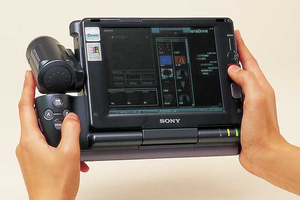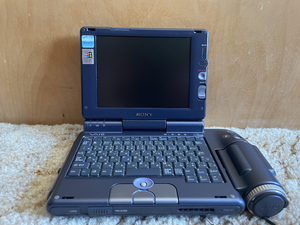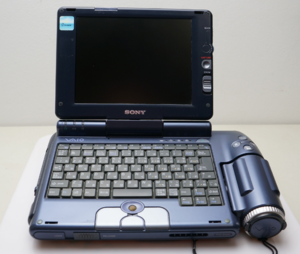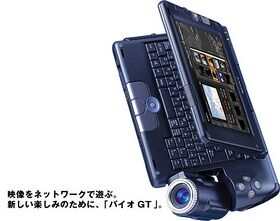PCG-GT: Difference between revisions
More actions
Resident007 (talk | contribs) |
Resident007 (talk | contribs) mNo edit summary |
||
| (3 intermediate revisions by 2 users not shown) | |||
| Line 1: | Line 1: | ||
== | {{Infobox Specs | ||
| name = PCG-GT | |||
| image = PCG-GT JP.jpg | |||
| subtitle = Sony VAIO PCG-GT3 promotional image | |||
| series = GT | |||
| rel = 2000 | |||
| cpu = Transmeta Crusoe TM5600, 600MHz | |||
| gpu = ATI RAGE Mobility M1, 8MB VRAM | |||
| chipset = Intel 82371 | |||
| memory = 128MB, max 256MB | |||
| display = 6.4" 1024×768 | |||
| storage = 20GB (GT1) or 30GB (GT3/K) 2.5-inch IDE | |||
| audio = Yamaha DS-XG in connection with Asahi Kasei audiochip | |||
| os = Microsoft Windows ME (GT1) or Microsoft Windows 2000 Professional (GT3/K) | |||
| weight = 1.1kg (2,42lbs) | |||
| size = 241 x 156 x 40mm | |||
| msrp = around $3000 | |||
}} | |||
==Overview== | |||
The Sony VAIO PCG-GT was a line of ultraportable subnotebooks with a built-in digital camera sold by Sony exclusively in Japan from November 2000 to late 2001. | |||
The original model, PCG-GT1 released on November 18, 2000. A higher-end model featuring darker colors and larger hard drive, PCG-GT3 (/K) was released on June 30, 2001. | The original model, PCG-GT1 released on November 18, 2000. A higher-end model featuring darker colors and larger hard drive, PCG-GT3 (/K) was released on June 30, 2001. | ||
| Line 6: | Line 25: | ||
Both models featured a large camera with 10x optical zoom on the side, intended to be primarily used for taking pictures that could later be shared on an image sharing service ImageStation, and for video recording and live streaming to PercasTV service, one of the first live video streaming services. | Both models featured a large camera with 10x optical zoom on the side, intended to be primarily used for taking pictures that could later be shared on an image sharing service ImageStation, and for video recording and live streaming to PercasTV service, one of the first live video streaming services. | ||
[[File:PCG-GT1-handheld.png|thumb|PCG-GT1 in camcorder mode]] | [[File:PCG-GT1-handheld.png|thumb|PCG-GT1 in camcorder mode]] | ||
Since the PCG-GT is designed like a sort of camcorder, the lid is able to rotate 180°, meaning you can close the lid with the display on the outside. The camera is also able to rotate vertically, allowing for a fairly pleasing experience when taking pictures or videos. The PCG-GT is able to capture pictures up to 640x480 resolution, and videos up to 640x480 (15FPS) or 320x240 (30FPS) in AVI format. | Since the PCG-GT is designed like a sort of camcorder, the lid is able to rotate 180° like many 2-in-1 laptops in the 2000s, meaning you can close the lid with the display on the outside. The camera is also able to rotate vertically, allowing for a fairly pleasing experience when taking pictures or videos. The PCG-GT even has tripod mount at the base of the machine for stabilized video streaming, and a lens cover is also bundled. The PCG-GT is able to capture pictures up to 640x480 resolution, and videos up to 640x480 (15FPS) or 320x240 (30FPS) in AVI format. | ||
Build quality is good, made out of metal for the lid, and plastic for the rest. The keyboard, being much smaller than full size because of the form factor of the device, is still usable, however don't expect a very pleasing experience. No trackpad is provided, only a trackpoint. | Build quality is good, made out of metal for the lid, and plastic for the rest. The keyboard, being much smaller than full size because of the form factor of the device, is still usable, however don't expect a very pleasing experience. No trackpad is provided, only a trackpoint. | ||
| Line 14: | Line 33: | ||
Some of the design choices featured in PCG-GT line were carried over to the [[PCG-U]] line in 2002. | Some of the design choices featured in PCG-GT line were carried over to the [[PCG-U]] line in 2002. | ||
There were two models released, PCG-GT1 and PCG-GT3 (/K). Both of them were very similar aside from a few minor differences in appearance, different hard drives, and Windows 2000 instead of ME in PCG-GT3. Both featured a Transmeta Crusoe TM5600 processor built on [[wikipedia:Very_long_instruction_word|VLIW]] architecture, similar to the TM5800 found in PCG-U series, however the one in PCG-GT is earlier and thus slower.[[File:PCG-GT1.png|thumb|Sony VAIO PCG-GT1]] | |||
There were two models released, PCG-GT1 and PCG-GT3 (/K). Both of them were very similar aside from a few minor differences in appearance, different hard drives, and Windows 2000 instead of ME in PCG-GT3. Both featured a Transmeta Crusoe TM5600 processor built on [[wikipedia:Very_long_instruction_word|VLIW]] architecture, similar to the TM5800 found in PCG-U series, however the one in PCG-GT is earlier and thus slower. | |||
[[File:PCG-GT1.png|thumb|Sony VAIO PCG-GT1]] | |||
[[File:PCG-GT3-K.png|thumb|Sony VAIO PCG-GT3/K]] | [[File:PCG-GT3-K.png|thumb|Sony VAIO PCG-GT3/K]] | ||
==Daily Usage Today== | ==Daily Usage Today== | ||
Much like back then, the PCG-GT is slow, and is only good enough for light tasks of its era. Camera is not acceptable by modern standards, but was fairly good back then. There is little to no usability in modern tasks for any PCG-GT model. | Much like back then, due to the limitations of Crusoe processor, the PCG-GT is slow, and is only good enough for light tasks of its era. Camera is not acceptable by modern standards, but was fairly good back then, and still able to produce crisp albeit low resolution pictures. There is little to no usability in modern tasks for any PCG-GT model. | ||
Due to the small production quantity and the interesting design of the machine, the PCG-GT is the holy grail of some VAIO enthusiasts, therefore the second hand market price of it has skyrocketed in recent years. It is nearly impossible to get one with reasonable price, but if you are able to get one of these, the best usage would be to use it as a vintage camcorder. | |||
==Resources== | ==Resources == | ||
===== Recovery Discs ===== | =====Recovery Discs===== | ||
{| class="wikitable" | {| class="wikitable" | ||
|PCG-GT1 | |PCG-GT1 | ||
| Line 70: | Line 48: | ||
|} | |} | ||
===== Hard drive images ===== | =====Hard drive images===== | ||
{| class="wikitable" | {| class="wikitable" | ||
|PCG-GT1 | |PCG-GT1 | ||
| Line 76: | Line 54: | ||
|} | |} | ||
===== Manuals and Useful Links ===== | =====Manuals and Useful Links===== | ||
{| class="wikitable" | {| class="wikitable" | ||
|PCG-GT1 | |PCG-GT1 | ||
| Line 85: | Line 63: | ||
|} | |} | ||
===== Disassembly Guide ===== | =====Disassembly Guide===== | ||
[https://www.youtube.com/watch?v=DleoLLrvpdc Sony VAIO PCG-GT1 Disassembly Guide] | [https://www.youtube.com/watch?v=DleoLLrvpdc Sony VAIO PCG-GT1 Disassembly Guide] | ||
==Credits== | ==Credits== | ||
[https://sony.com Sony], [https://pc.watch.impress.co.jp/ pc.watch.impress.co.jp] | [https://sony.com Sony], [https://pc.watch.impress.co.jp/ pc.watch.impress.co.jp] | ||
Latest revision as of 10:06, 23 February 2025
Overview
The Sony VAIO PCG-GT was a line of ultraportable subnotebooks with a built-in digital camera sold by Sony exclusively in Japan from November 2000 to late 2001.
The original model, PCG-GT1 released on November 18, 2000. A higher-end model featuring darker colors and larger hard drive, PCG-GT3 (/K) was released on June 30, 2001.
Both models featured a large camera with 10x optical zoom on the side, intended to be primarily used for taking pictures that could later be shared on an image sharing service ImageStation, and for video recording and live streaming to PercasTV service, one of the first live video streaming services.

Since the PCG-GT is designed like a sort of camcorder, the lid is able to rotate 180° like many 2-in-1 laptops in the 2000s, meaning you can close the lid with the display on the outside. The camera is also able to rotate vertically, allowing for a fairly pleasing experience when taking pictures or videos. The PCG-GT even has tripod mount at the base of the machine for stabilized video streaming, and a lens cover is also bundled. The PCG-GT is able to capture pictures up to 640x480 resolution, and videos up to 640x480 (15FPS) or 320x240 (30FPS) in AVI format.
Build quality is good, made out of metal for the lid, and plastic for the rest. The keyboard, being much smaller than full size because of the form factor of the device, is still usable, however don't expect a very pleasing experience. No trackpad is provided, only a trackpoint.
A total of 5000 PCG-GT1 units were made. The number of PCG-GT3 units produced is unknown, but is likely the same as for PCG-GT1.
Some of the design choices featured in PCG-GT line were carried over to the PCG-U line in 2002.
There were two models released, PCG-GT1 and PCG-GT3 (/K). Both of them were very similar aside from a few minor differences in appearance, different hard drives, and Windows 2000 instead of ME in PCG-GT3. Both featured a Transmeta Crusoe TM5600 processor built on VLIW architecture, similar to the TM5800 found in PCG-U series, however the one in PCG-GT is earlier and thus slower.


Daily Usage Today
Much like back then, due to the limitations of Crusoe processor, the PCG-GT is slow, and is only good enough for light tasks of its era. Camera is not acceptable by modern standards, but was fairly good back then, and still able to produce crisp albeit low resolution pictures. There is little to no usability in modern tasks for any PCG-GT model.
Due to the small production quantity and the interesting design of the machine, the PCG-GT is the holy grail of some VAIO enthusiasts, therefore the second hand market price of it has skyrocketed in recent years. It is nearly impossible to get one with reasonable price, but if you are able to get one of these, the best usage would be to use it as a vintage camcorder.
Resources
Recovery Discs
| PCG-GT1 | Internet Archive |
Hard drive images
| PCG-GT1 | Internet Archive |
Manuals and Useful Links
| PCG-GT1 | Internet Archive |
| PCG-GT1 (English translated) | Internet Archive |

